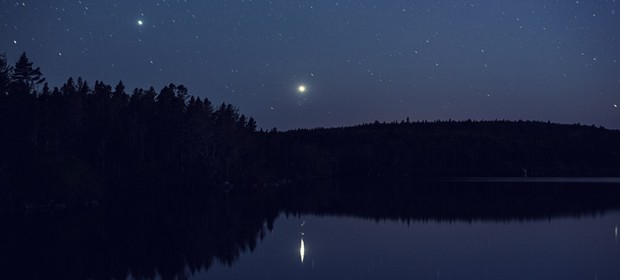The planet Venus is the third brightest object in the heavens after the Sun and the Moon. And this month into next it puts on quite a show in the western sky after sunset. There are several things about this “Goddess of Love” of mythology that may surprise you, so read on.
This radiant gem rivets your attention on clear nights as soon as you step outdoors. On January 12th Venus reaches what is known as “greatest eastern elongation”—its greatest angular distance from our Daytime Star in the sky. As small telescopes will show, it’s then at its half-full phase, having moved in its orbit from around the other side of the Sun. As bright as Venue appears, it won’t actually reach its maximum brightness until mid-February. And here’s one of those interesting facts: it’s then in its crescent phase—not full phase which you might think, as is the case of our Moon. This is because it’s not only closer to us as it approaches our side of the Sun but the crescent is many times larger than the disk of the planet at any other phase—even when full (but remote) on the other side of its orbit.
Another fascinating fact about Venus is that around the time it’s brightest in the sky it can actually cast shadows in the winter on snow-covered ground. Face the planet and then turn around to see your shadow! (This supposes that you are looking at it in a relatively non-light-polluted location, which means avoiding porch and street lights.) In lieu of snow, place a sheet on the ground behind you. It’s truly amazing to see your shadow cast by a planet millions of miles away!
Here’s two more factoids about this glorious orb to think about as you gaze upon it on January evenings: Venus has often been referred to as the Earth’s “sister planet” because it’s almost identical in size. But that’s where the resemblance ends. Its atmosphere is some 90 times as dense as ours, resulting in a runaway greenhouse effect that causes the surface temperature to reach nearly 900 degrees Fahrenheit! Also, if that isn’t bizarre enough, Venus is actually flipped upside down and rotates backwards with respect to the other planets!
Finally, as an added treat, on the evening of January 1st a beautiful crescent Moon will appear to the lower right of Venus and on the following evening to the upper left of it. (And further still to the upper left of the Moon that night is ruddy-orange Mars, now quite faint and remote from us.)
— James Mullaney
Former assistant editor at Sky & Telescope magazine & author of nine books on stargazing. His latest, Celebrating the Universe!, is available from HayHouse.com.


